Latest News Blog
June 2014
Remarkable War Heroes!
Monday, 30th June 2014
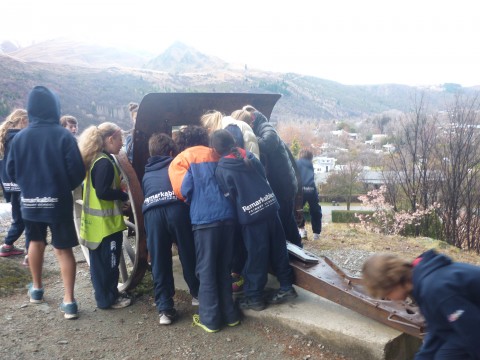
Checking out the Turkish Field Gun that is beside the Arrowtown war memorial
100 year 5 and 6 students from Remarkables Primary School visited the Lakes District Museum & Gallery today to learn about WWI and the Wakatipu regions war heroes.
This 2 hour programme included:
- A PowerPoint presentation where students learned about local war heroes from the Wakatipu region. These heroes included soldiers and nurses.
We discussed the meaning of the word hero, and who the word could be applied to – including WWI soldiers and nurses, family members, and members from the community who had done something brave. - Students were then shown, and had the opportunity to handle trench art which was made in the trenches. Living conditions in the trenches were discussed.
- Students were shown a display of medals in the museum earned by nurse Mildred Rees whose father founded Queenstown.
- Students were then taken up to the Arrowtown war memorial, where students discussed and learned the importance of war memorials and why they are built.
- The trip to the war memorial also included students seeing a Turkish field gun which is based beside the memorial.
Students took in a lot of information as they had so many interesting questions! We also discussed trench foot, trench mouth, shell shock, and some of the students own personal stories of relatives who had served overseas.
What was the most interesting thing you learnt during your visit to the museum?
Who was your favourite hero that we discussed during your visit?
What interesting things will you do in your classroom after being inspired by your visit to the museum?
Answer my questions and comment about your visit below!
Thanks for visiting Remarkables school. You are all REMARKABLE learners!
South Otago High School Seek Historical Knowledge
Monday, 30th June 2014
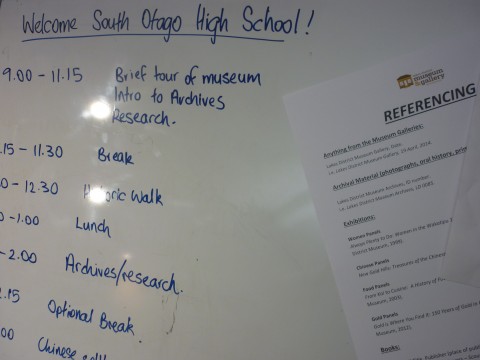
The busy itinerary for the day!
On Friday the 27th June, 17 students from South Otago High School made a trip to the Lakes District Museum & Gallery for some historical research.
These year 13 students, had access to some amazing resources including our full collection of photographs dating from the 1860's, a burial register from the Queenstown cemetery, and a court wardens book that documented court cases from the 1870's.
Students also spent this time researching information about the Chinese settlers, law and order, women on the goldfields, economic activity, and living conditions. Our library of topic specific books was a great help to these students, especially our 1948 oral history transcripts!
Students were given a historic walk of Arrowtown which included a visit to the Old Gaol. A tour of the Chinese settlement was also part of the itinerary for the day.
What did you enjoy researching at the Lakes District Museum?
Did you find the visit to the museum useful for your research?
Answer my questions and comment about your visit to the Museum below!
The amount of research the students managed to squeeze into one day was high impressive. Well done South Otago History students - I look forward to your school visiting again next year.
Waikoikoi Wonder About the Past
Wednesday, 25th June 2014
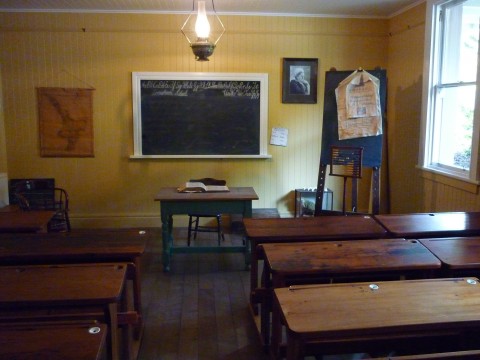
Miss Grays classroom ...
Waikoikoi students visited the Lakes District Museum today to learn about the past...
It was a scary start to a Wednesday morning with Miss Gray making an appearance, but all of the students were very brave and survived a whole lesson with her! During the lesson students had to sit with their back straight, and finish their answers with "Miss Gray". During the lesson students memorized a poem; practiced their cursive handwriting; learnt the twelve times tables and arithmetic with pennies, shillings, and pounds; and finished the lesson with a physical drill. One naught student even got a caning for playing in the girls playground!
After morning tea students explored the museum. We started the session with an artefacts timeline where students got to handle a moa bone, a poha, a pounamu mere, and some other very precious items. Students then explored the museum whilst learning about some specific displays on life during the 1800's. Everyone enjoyed visiting the long drop display, and the girls were interested in learning about the corset on display. It wasn't easy being a lady during the 1800's!
What was your favourite part of the visit?
What was something new you learned during the visit?
Do you think learning today is easy or hard compared to over a 100 years ago? Why?
What was your favourite artefact that you got to handle?
Answer some of my questions or just comment about your visit below!
We really enjoyed having you come visit Waikoikoi, come again soon!
Going For Geology!
Monday, 23rd June 2014
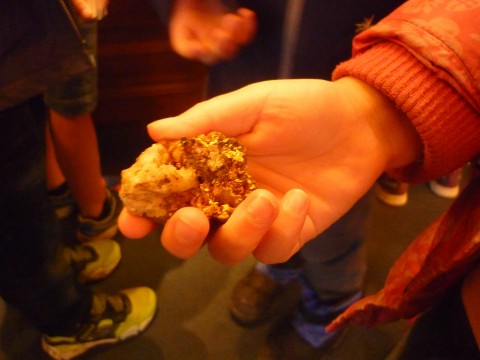
Handling gold at the Gold Shop!
Year 3 and 4 students from Arrowtown are GOING to the Museum for GEOLOGY!
Planned visits are being made to the Lakes District Museum & Gallery, where students are introduced to the geology of the Wakatipu region by listening to a story which covers information about Gondwanaland , the formation of New Zealand, tectonic plates moving, the ice age, schist, gold, quartz, and pounamu.
Students are also visiting Justin at the Gold Shop, where Justin speaks about the geological formation of gold and its uses. He also lets the students handle some very expensive gold nuggets and jewellery! One nugget is worth $15,000! The gold the students get to see is really heavy and very bright.
The students are also visiting Leroy at the Jade Factory. Leroy explains the characteristics of pounamu such as how hard it is. He demonstrates this by smashing his hammer against it. It makes a loud sound, and when he shows us the hammer, it is flattened!
A quick visit to Buckingham green is also included in the programme. Students explore the large schist boulder at the green and discuss its characteristics as well as how it was formed into a metamorphic rock.
Back at the museum, students are also shown our Geology display which shows the HUGE variety of rocks from this region, including some eratic rocks. Students also have the opportunity to handle more rocks which had been found in the Wakatipu region. Some were about 30, 000 years old! In some of these rocks there are shells (molluscs) and a sharks tooth! Other rocks the students get to handle include: quartz, scheelite, tungsten, a bowenite adze, a greywacke adze, and of course schist.
Helping Arrowtown students learn about geology is wonderful. It's an information overload, but all of the students are such keen learners so everyone is enjoying themselves a lot!
Thank you so much to David the Museum Director, Leroy form the Jade Factory, and Justin from the Gold Shop for contributing to the programme and sharing all of your knowledge with the students!
What are the four rocks and elements you learned about during your visit?
Which rock or element do you like the best? Why?
Can you remember what the term erratic rock means?
How long does it take rocks to form?
What are some other interesting things you learned during your visit?
Answer my questions and comment about your visit below!
Remarkable Art!
Wednesday, 18th June 2014
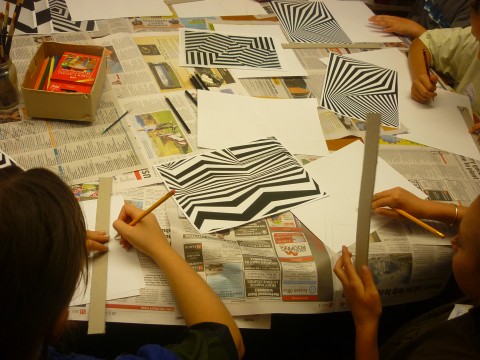
Sketching out Dazzle camouflage!
As many of you will already know, the Museum has been celebrating the centenary of WWI this year through a variety of ways. We are hosting an exhibition later this year to commemorate the Wakatipu war effort during WWI, and we have also made available extension art workshops which focus on the theme of camouflage.
Alexandra Primary School, Garston Primary School, Arrowtown Primary School, and now Remarkables Primary School have all worked with myself at the museum to create some fantastic WWI inspired art. This morning, 10 students from Remarkables Primary school created some amazing pieces of camouflage art. Other workshops have usually been inspired by animal camouflage and army camouflage prints. But today these students were inspired by DAZZLE camouflage!
During WWI, the Allies (Britain, France, and Russia) also used Dazzle camouflage that was very easy to spot! They realized it was very difficult to disguise large fleets of their ships out at sea. No matter what colours they used, the ships were always easily sighted. Starting with Britain, the Allies decided to paint black and white patterns all over their ships instead! These patterns drew attention to their ships, because the colours were so bold and the straight lines that were used were so obvious. But these patterns covered the ships completely and made it difficult for enemy submarines to figure out how large the ship truly was, and where exactly to target enemy fire at the ships!
This camouflage was not used to hide these ships, it was used to confuse the enemy! This type of camouflage became known as "Dazzle" camouflage.
Our inspiration for our artworks also came from three VERY different artists:
- Desiree Palmen is a Dutch artist who paints peoples clothes to help them blend into the city, which she then takes photos of.
- Andy Warhol liked the idea of how camouflage hides things, but when he created his camouflage prints he painted them in bright colours so that two opposite ideas of hiding and being easily seen were combined.
- Reuben Paterson is a kiwi artist who likes to incorporate glitter into his artworks of kowhaiwhai patterns.
The works these students created were AMAZING! I was so impressed by the high quality of the pieces of art - I can't wait to run another workshop!
What did you enjoy about the Art workshop?
What was something new you learned at the workshop?
How are you going to display your pieces of art at home??
Answer my questions and comment about your visit below!
South by South East
Wednesday, 18th June 2014
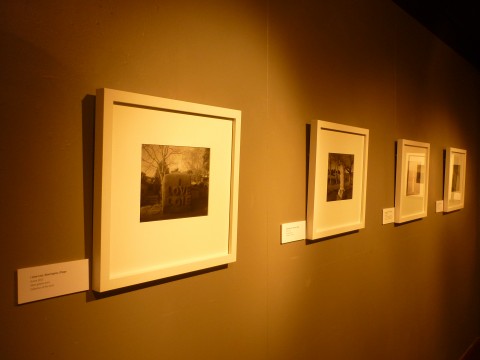
War memorials, gravestones, and the "I Love Louis" hedge which has been trimmed in that style for years since the owner proposed to his wife.
South by South East is a collection of 40 photographic works by Laurence Aberhart which celebrates the landscapes and landmarks of Otago and Southland.
Photographs in the exhibition include iconic central Otago imagery, gravestones (from WWI), war memorials (from WWI), landscapes, interiors of masonic lodges, and display cases from an anatomy museum! This eclectic black and white collection portrays fantastic technique of the photographer in capturing the mundane and the interesting but making all images equally appealing to view.
Laurence is one of New Zealand’s most distinguished photographers and has displayed his work around the world. Bring your photography and visual arts students to encourage them to study the arts at a teritary level or to visit this exhibtion to inspire their own NCEA art boards.
This exhibition will run from 15th June - 3rd August 2014.
Have you visited the exhibition?
What do you think of Laurence's work?
What do you think of the subject matter?
Answer my questions and comment on the blog below!
DAZZLE!
Tuesday, 17th June 2014
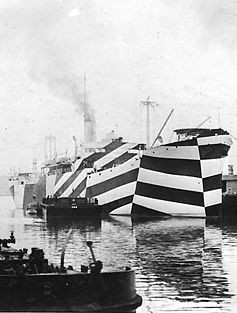
USS West Mahomet in dazzle camouflage, 1918 - photo courtesy of wikipedia
We always think camouflage is for hiding and concealing things. Animals use it in the wild to blend into their habitats so that predators can't spot them, hunters (humans and animals alike) wear it so that their targets cannot see them, and the army has a long tradition of including it as part of their uniform to prevent soldiers being seen in the battlefields.
But during WWI the Allies (Britain, France, and Russia) also used a completely different type of camouflage that was very easy to spot! They realised it was very difficult to disguise large fleets of their ships out at sea. No matter what colours they used, the ships were always easily sighted. Starting with Britain, the Allies decided to paint black and white patterns all over their ships instead! These patterns drew attention to their ships, because the colours were so bold and the straight lines used were so obvious. But these patterns covered the ships completely and made it difficult for enemy submarines to figure out how large the ship truly was, and where exactly to target enemy fire at the ships!
This camouflage was not used to hide these ships, it was used to confuse the enemy! This type of camouflage became known as "Dazzle" camouflage.
Do you know any quirky facts like this about WWI?
Do you think the Dazzle camouflage was successful?
Why don't we use Dazzle camouflage today?
What do you think of Dazzle camouflage?
Answer my questions and comment on the blog below!
Did You Know?
Wednesday, 11th June 2014
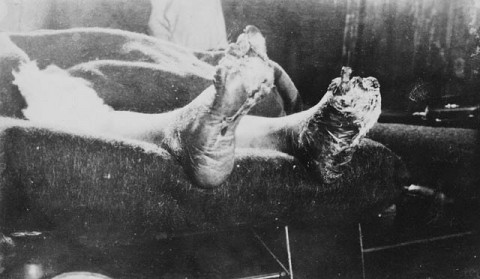
A very bad case of trench foot - photo sourced from Wikipedia
Did you know that apart from the Germans, the New Zealanders' biggest enemy at Passchendaele during WWI were the terrible living conditions in the trenches?
The muddy and wet conditions gave many New Zealand soldier's trench foot! Trench foot was caused by soldiers having their feet in damp, unsanitary, and cold conditions for really long periods of time. It made their feet go numb, turn blue, and then begin to swell! If it got really bad the soldiers feet would get covered in open sores and blisters as well. Sometimes their feet had to get amputated too!
The hard living conditions in the trenches also gave soldiers trench fever, from the HUGE amount of lice that lived in the trenches. The lice weren't the only creatures to enjoy living in the trenches ... Rats were reported to grow as large as cats, as they thrived in the gross conditions.
Read more about the soldiers experience in the trenches at NZHistory!
Junior Geologists!
Monday, 9th June 2014
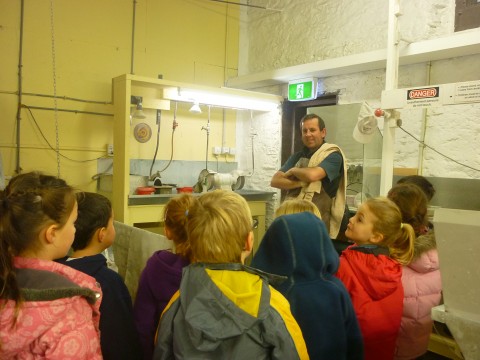
Leroy from the Jade Factory talks Pounamu
Year 2 students from Arrowtown are turning into Junior Geologists with their topic unit on the Geology of the surrounding area!
Planned visits were made to the Lakes District Museum & Gallery, where I introduced students to the geology of the Wakatipu region by reading a story which covered the information about Gondwanaland , the formation of New Zealand, tectonic plates moving, the ice age, schist, gold, quartz, and pounamu.
I then took the students to visit Justin at the Gold Shop, where Justin spoke about the geological formation of gold and its uses. He also let the students handle some very expensive gold nuggets and jewellery! One nugget was worth $15,000! The gold was really heavy and very bright.
The students then went on to visit Leroy at the Jade Factory. Leroy explained the characteristics of pounamu such as how hard it was. He demonstrated this by smashing his hammer against it. It made a loud sound, and when he showed us the hammer, it was flattened!
We then returned to the museum, where I showed students more rocks which had been found in the Wakatipu region. Some were about 30, 000 years old! In these rocks we saw shells (molluscs) and a sharks tooth. The students also got to handle some schist rocks and quartz stones.
Helping Arrowtown students learn about geology has been wonderful. One student came up to me at the end of their visit and said they thought rocks were really exciting!
What are the four rocks and elements you learned about during your visit?
Which rock or element do you like the best? Why?
What did the Maori use pounamu for?
What did the settlers use gold for?
What are some other interesting things you learned during your visit?
Answer my questions and comment about your visit below!
Lake Hayes
Friday, 6th June 2014

Reflections on Lake Hayes
Driving to work this morning, I saw some beautiful reflections on Lake Hayes.
The lake will often have a glass like surface which reflects the surrounding hills, making a very pretty landscape! It's no coincidence that Lake Hayes as well as a few other lakes in the district picked up the the nickname "the mirror lakes".
Lake Hayes was named originally after the discoverer, Donald Hay. So it used to be known as "Hay's Lake". But, somehow over the years it began being spelt as "Hayes"... I wonder if the spelling got confused with a well known scoundrel called Bully Hayes, who moved to the area during the late 1800's?
Bully Hayes, ran a hotel in Arrowtown during the late 1800's, and had a bad reputation due to cheating at cards, and other shady business dealings. It was rumoured that he had his ear cut off as punishment for crimes he had committed in the past, so he wore his hair rather long to conceal this. He married the daughter of a rival hotel owner, and the father was so outraged he issued a reward for anyone who would cut Bully Hayes' hair to reveal the missing ear.
Do you know any other interesting facts about Lake Hayes?
Have you walked the track around Lake Hayes?
Have you heard about Bully Hayes before?
Answer my questions and comment on this blog below!
Art2Wear Exhibition
Tuesday, 3rd June 2014
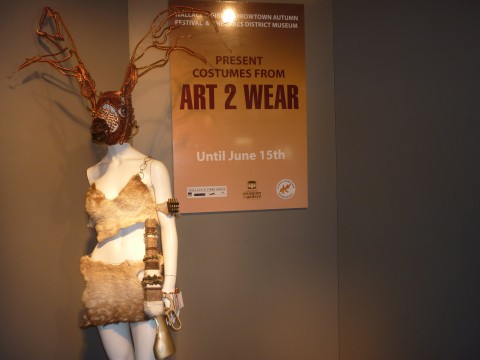
"The Hunter Games"
Part of the Arrowtown Autumn Festival, the Art 2 Wear show is one of the most popular ticketed events. Local designers compete in one of four categories to produce the best Art 2 Wear fashion.
These entries are now on display at the Lakes District Museum & Gallery from the 30th May until the 15th June 2014. A visit to this exhibition could provide inspiration for fabric and technology units at your school. Viewing this exhibition could also provide a valuable learning experience for examining the design process and for appreciating different forms of art.
Which is your favourite piece?
The materials used to create these garments are very unusual. Some of these include rat skulls, bubble wrap, birds nests, wire, divorce papers, and marriage certificates! Why do you think the designers use such interesting materials?
Have you visited our exhibition yet?
Answer my questions and comment about this exhibition on our blog!
How about you try making your own wearable art at home or school, by using old newspapers?!
What Caused the Outbreak of WWI?
Tuesday, 3rd June 2014
There were a lot of contributing factors for why WWI broke out in 1914, so it can be a bit tricky to understand if you are just beginning to study WWI. Watch these two videos below to help you figure out the many events (and alliances!) which brought about the Great War.
Did these videos help you understand why WWI broke out?
Did these videos help you with your class work on WWI?
What parts of the video did you enjoy watching?
Comment about these videos and post your answers to my questions on this blog!






















































